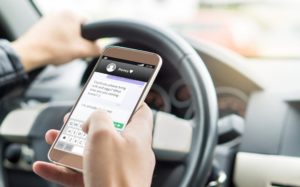Introduction
Connecticut distracted driving is a pressing issue that has garnered significant attention in recent years.
Distracted driving refers to any distraction that interferes with a driver’s ability to focus on the task of driving. This includes visual distractions (looking at a phone), manual distractions (texting), and cognitive distractions (daydreaming). Each of these types of distractions increases the risk of an accident by diverting attention from the road.
Connecticut Distracted Driving – Impact on Victims and Families
The aftermath of a distracted driving incident can be devastating for victims and their families. Personal injury claims often arise from these accidents, as injured parties seek compensation for medical bills, lost wages, and pain and suffering. In Connecticut, victims must prove that the distracted driver was negligent, which can include evidence of texting or using a mobile device at the time of the crash.Personal injury claims can be complex, requiring thorough documentation and sometimes expert testimony. Therefore, victims should be aware of their rights and the legal processes involved in seeking compensation to ensure they receive the support they need during recovery.
Texting While Driving
Texting while driving is one of the most dangerous forms of distracted driving. The National Highway Traffic Safety Administration (NHTSA) has reported that texting drivers are 23 times more likely to be involved in an accident than non-texting drivers. This behavior combines all three types of distraction: visual, manual, and cognitive, making it exceedingly dangerous.

Using Mobile Apps
In addition to texting, using mobile applications while driving has become increasingly common with the rise of smartphone usage. Apps for navigation, social media, and music can easily divert attention from the road. Drivers may feel compelled to check notifications or adjust settings mid-drive, which can significantly increase the risk of collisions.
Other Distractions (e.g., Eating, Talking to Passengers)
While texting and using apps are notable distractions, other activities such as eating, grooming, or conversing with passengers also pose significant risks. Studies indicate that eating while driving can lead to impaired control of the vehicle and an increased likelihood of accidents. Similarly, engaging in deep conversations with passengers can distract drivers from the road.
Connecticut Distracted Driving – Personal Injury Claims
Steps to Take Immediately Following an Accident
In the aftermath of a distracted driving accident, it is crucial to remain calm and take appropriate steps. The first priority should be ensuring everyone’s safety. If possible, move vehicles out of the roadway to prevent further collisions. Call 911 for medical assistance and report the accident.
Document the scene thoroughly by taking photographs, noting the time and location, and gathering contact information from witnesses. This information will be invaluable when pursuing a personal injury claim and dealing with insurance companies.
Gathering Evidence for Personal Injury Claims
Evidence is key to a successful personal injury claim. After the accident, collect all relevant documentation including medical records, police reports, and witness statements. If the other driver was distracted, gather evidence that supports this claim, such as mobile device usage or eyewitness accounts.
Maintaining detailed records of medical treatments and expenses is also essential, as these will be necessary for calculating damages in a claim. The more comprehensive the evidence, the stronger the case for compensation.
Consulting with a Personal Injury Attorney
After a distracted driving accident, consulting with a personal injury attorney is highly recommended. An experienced attorney can guide victims through the complex legal landscape, helping them understand their rights and options. Moreover, attorneys can provide insights into potential compensation amounts based on evidence collected.
Legal representation ensures that victims are adequately compensated for their injuries and damages, allowing them to focus on recovery rather than navigating the legal system alone.
Consultation and Representation
I represent clients in Connecticut distracted driving and all related personal injury matters through out Fairfield and New Haven Counties including those who reside in Easton, Fairfield, Monroe, Trumbull, Stratford, Bridgeport, Westport, Weston, New Canaan, Wilton, Norwalk, Darien, Stamford, Greenwich, Shelton, Orange and Milford.
Please email me or call me in Stamford at (203) 356-1475 or in Fairfield at (203) 259-5251 to schedule a free, no cost consultation today.
